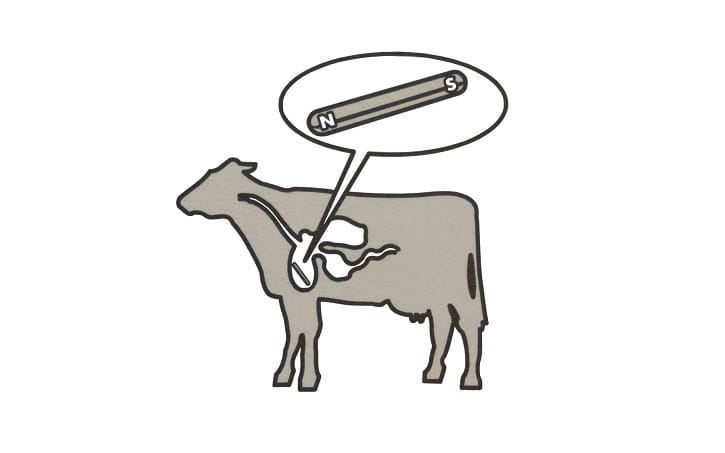The Vital Role of Cow Magnets in Preventing Hardware Disease in Cattle
Cow magnets are a crucial piece of veterinary equipment that play a vital role in preventing a dangerous condition known as hardware disease in cattle.

Cow magnets are a crucial piece of veterinary equipment that play a vital role in preventing a dangerous condition known as hardware disease in cattle. [1] This article will provide a comprehensive overview of cow magnets, including what they are, how they work, and why they are an essential tool for farmers and ranchers.
What is Hardware Disease in Cattle?
Hardware disease, also known as bovine traumatic reticulopericarditis, is a common issue that affects cattle, particularly dairy cows. [1] It is caused by the ingestion of sharp, metallic objects such as nails, wires, or other pieces of hardware. These objects can become lodged in the animal's reticulum (the second compartment of the stomach) and can irritate or even puncture the lining, leading to serious health problems.
Hardware disease can be difficult to diagnose, as the symptoms can be vague and non-specific. Common signs include decreased appetite, weight loss, fever, and abdominal pain. If left untreated, the condition can progress to more severe complications, such as peritonitis, pericarditis, and even death. [1]
How Do Cow Magnets Work?
Cow magnets are a simple yet effective solution to prevent hardware disease in cattle. These magnets are typically made of strong Alnico or ferrite materials and are shaped like a smooth rod, approximately 1 cm by 8 cm (0.4 by 3.1 inches) in size. [1]
When a cow swallows a cow magnet, it settles in the animal's reticulum and remains there for the rest of the cow's life. The magnet acts as a trap, attracting any metallic objects the cow may ingest and preventing them from becoming lodged in the animal's tissue. [1]
While the resulting mass of metal remains in the cow's rumen as a pseudobezoar (an intentionally introduced bezoar), it does not cause the severe problems associated with hardware disease. The magnet effectively neutralizes the threat, allowing the cow to continue living a healthy and productive life.
Administering Cow Magnets
Cow magnets are typically administered to calves at the time of branding, around the age of one year. [1] This is the most effective time to introduce the magnet, as it will have the maximum amount of time to settle in the animal's reticulum and begin its protective function.
The process of administering a cow magnet is relatively straightforward. The animal is first fasted for 18-24 hours to ensure the rumen is empty. The magnet is then placed in a balling gun, a specialized tool used to administer oral medications to cattle, and gently inserted into the animal's mouth. The cow is then allowed to swallow the magnet, which will then settle in the reticulum.
The Importance of Cow Magnets
Cow magnets are an essential tool for farmers and ranchers, as they provide a simple and effective way to prevent hardware disease in their herds. [1] This condition can be devastating, leading to significant economic losses due to decreased productivity, veterinary expenses, and even the loss of valuable animals.
By administering cow magnets to their herd, farmers and ranchers can significantly reduce the risk of hardware disease and ensure the health and well-being of their cattle. This, in turn, can lead to increased milk or meat production, lower veterinary costs, and a more profitable and sustainable operation.
Advancements in Cow Magnet Technology
While traditional cow magnets have been in use for decades, the technology behind these essential tools has continued to evolve. [1] Today, cow magnets are more commonly made up of several ring-shaped ferrite magnets attached to a stainless-steel or plastic core, rather than a single Alnico magnet.
These newer designs offer several advantages over the traditional cow magnet. They are often more durable and resistant to corrosion, ensuring a longer lifespan and continued effectiveness. Additionally, the multi-magnet design can provide a stronger and more consistent magnetic field, further enhancing the magnet's ability to attract and trap metallic objects.
Conclusion
Cow magnets are a vital tool in the prevention of hardware disease, a dangerous and potentially life-threatening condition that can affect cattle, particularly dairy cows. By administering these magnets to their herds, farmers and ranchers can effectively trap and neutralize any metallic objects the animals may ingest, protecting their livestock and ensuring the overall health and productivity of their operations.
As the technology behind cow magnets continues to evolve, it is clear that these simple yet essential tools will remain a crucial component of modern cattle farming and ranching. By understanding the importance of cow magnets and incorporating them into their herd management practices, farmers and ranchers can safeguard the well-being of their animals and the long-term success of their businesses.
Citations:
[1] https://www.stanfordmagnets.com/cow-magnets.html
[2] https://www.stanfordmagnets.com/everything-you-need-to-know-about-rare-earth-magnets.html
[3] https://www.stanfordmagnets.com/types-and-characteristics-of-rare-earth-magnets.html
[4] https://newscenter.lbl.gov/2021/07/20/worlds-thinnest-magnet/
[5] https://www.stanfordmaterials.com/news.html
[6] https://news.stanford.edu/2019/03/18/new-way-generate-hydrogen-fuel-seawater/